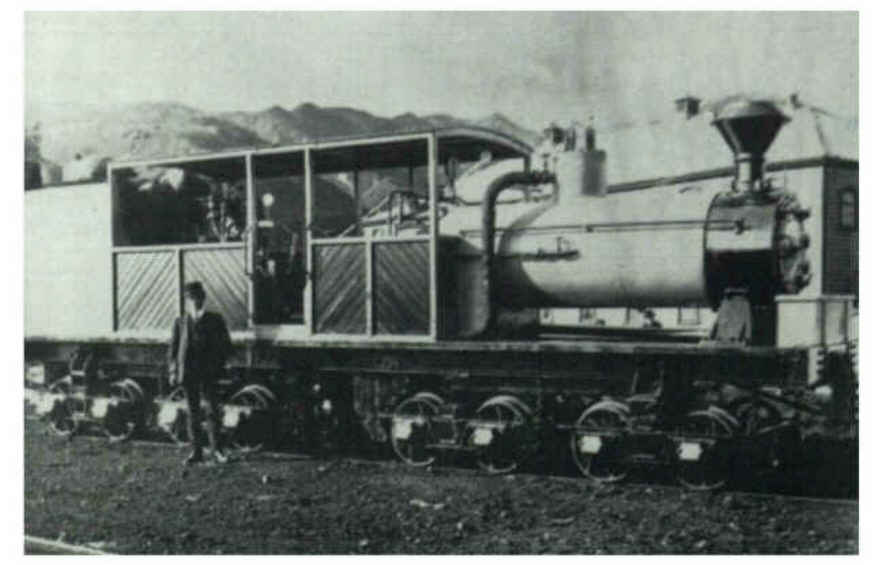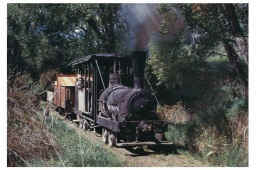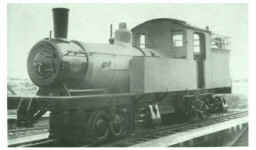
A & G Price Ltd., Thames

(Percy Godber)
A & G Price Ltd. of Thames built 22 geared logging locomotives in the period from 1885 until 1943. Other manufacturers undoubtedly influenced some of their locomotive designs and one could say that Price's were not innovative. But their engineering skills and quality were unsurpassed which was proven by the performance in the bush and the longevity of their designs. Price attained their boom sales in the period 1920 to 1929 when they completely dominated the market. They even sold new locomotives into the distant South Island's West Coast, the heart of Davidson and Dispatch territory.
With the tendency of Price to copy other's designs, they did achieve reliability as most of the features were well proven overseas, such as the skew bevel gears of Climax which avoided the complicated truck designs of Dispatch and Johnston. Probably a good example of selective copying was their Type E, which was similar in configuration to the Climax, yet had Heisler styled trucks as these performed better on rough trackwork and suffered less from broken axles. Price did however use piston valves to achieve better performance even with saturated steam use.
Price was uncharacteristically innovative with their 1927 Type Ar, a two-truck Meyer type locomotive weighing 32 tonnes and having two cylinders on each truck driving to a jackshaft thence through gears to the axles. This was the biggest geared locomotive to operate in New Zealand and was in service until 1946.
1885 0-4-0
 This, their first steam locomotive, employed two
cylinders arranged horizontally and driving through spur gears to the two axles.
It was constructed for a three-foot gauge tramway in the Te Aroha goldfields where
it stayed but a short time before entering the bush where it performed until 1908.
The Government Public Works Department then acquired it for railway construction in
the South Island before finally scrapping it in 1917. Only one lokey of this type was
built.
This, their first steam locomotive, employed two
cylinders arranged horizontally and driving through spur gears to the two axles.
It was constructed for a three-foot gauge tramway in the Te Aroha goldfields where
it stayed but a short time before entering the bush where it performed until 1908.
The Government Public Works Department then acquired it for railway construction in
the South Island before finally scrapping it in 1917. Only one lokey of this type was
built.
The little 0-4-0 geared Price of 1885 working for the Smyth brothers at Kennedy Bay. (H. Winkelmann)
1912 0-4-4-4-4-0 Price 16-Wheeler
 The 16-wheeler was a copy of several designs, the concept coming from the earlier Johnston
16-wheeler but using skew bevel gears based on the Climax A. A vertical two-cylinder
marine type engine having cylinders 7�in x 10in (190 x 254 mm) mounted in the cab and driving
a line shaft via a two-speed transmission drove the locomotive. Skew bevels then provided
drive to all axles. It was designed to negotiate a 66 feet (20-metre) radius curve and
weighed 36 tonnes, being heavier than its Johnston counterpart, and with an axle loading
of 2.25 tonnes. Like most geared engines they were not particularly fast and did not
perform on line haul work but did a magnificent job on the bush branch trackage.
Four 16-wheelers were constructed, the very first one in 1912 lasting in service
until 1951, a good record.
The 16-wheeler was a copy of several designs, the concept coming from the earlier Johnston
16-wheeler but using skew bevel gears based on the Climax A. A vertical two-cylinder
marine type engine having cylinders 7�in x 10in (190 x 254 mm) mounted in the cab and driving
a line shaft via a two-speed transmission drove the locomotive. Skew bevels then provided
drive to all axles. It was designed to negotiate a 66 feet (20-metre) radius curve and
weighed 36 tonnes, being heavier than its Johnston counterpart, and with an axle loading
of 2.25 tonnes. Like most geared engines they were not particularly fast and did not
perform on line haul work but did a magnificent job on the bush branch trackage.
Four 16-wheelers were constructed, the very first one in 1912 lasting in service
until 1951, a good record.
The Mountain Rimu Timber Co. Price 16-wheeler at Mamaku. (Percy Godber)
Length 32ft 3in (9843 mm), Wheelbase 24ft 4in (7417 mm), Truck wheelbase 2ft 6in (762 mm),
Boiler pressure 160 psi (1103 kPa), Wheel diam. 20in (508 mm)
1912 0-4-4-0 Price-C
 The Type C was essentially a copy of the Climax A and weighed about 12 tonnes.
A two-cylinder vertical cab-mounted engine drove through spur gears to the line shaft
below. Two speed changes were available from a pair of shifting spur gears on the
crankshaft engaging with a corresponding pair on the line shaft with dog clutches between.
The gear ratios in this set-up were 2:1 and 3:1 and final drive to the axles was by skew
bevels. The truck design was similar to Climax but used inside frames and smaller diameter
wheels. They were designed to negotiate 50 feet (15.2 metre) curves and grades up to
1 in 10. There were only two Type C engines built in 1921 and 1922, the latter lasting
until 1964.
The Type C was essentially a copy of the Climax A and weighed about 12 tonnes.
A two-cylinder vertical cab-mounted engine drove through spur gears to the line shaft
below. Two speed changes were available from a pair of shifting spur gears on the
crankshaft engaging with a corresponding pair on the line shaft with dog clutches between.
The gear ratios in this set-up were 2:1 and 3:1 and final drive to the axles was by skew
bevels. The truck design was similar to Climax but used inside frames and smaller diameter
wheels. They were designed to negotiate 50 feet (15.2 metre) curves and grades up to
1 in 10. There were only two Type C engines built in 1921 and 1922, the latter lasting
until 1964.
Price's Type C, working for Taringamutu Totara Sawmills,Taringamotu.(J.A.T. Terry)
Length 26ft 0in (7925 mm), Wheelbase 18ft 2in (5537 mm), Truck wheelbase 2ft 8in (813 mm),
Boiler pressure 130 psi (896 kPa), Cylinders 7in x 8in (178 x 203 mm), Wheel diam. 22in (559 mm).
1912 0-4-4-0 Price-D
 The Type D was introduced in the 1920s but only one
was ever constructed. It was offered as a lightweight engine therefore less expensive to
purchase and suited to very light rail. At 8 tonnes it resembled the Type C but it appeared
on the market when successful rail tractors were coming forward, these performing the same
tasks more effectively and economically.
The Type D was introduced in the 1920s but only one
was ever constructed. It was offered as a lightweight engine therefore less expensive to
purchase and suited to very light rail. At 8 tonnes it resembled the Type C but it appeared
on the market when successful rail tractors were coming forward, these performing the same
tasks more effectively and economically.
The neat little Type D ready to leave the Thames works.
(A & G Price)
Length 20ft 2in (6198 mm), Wheelbase 15ft 8in (4775 mm), Truck wheelbase 2ft 8in (813 mm),
Boiler pressure 140 psi (965 kPa), Cylinders 6in x 7in (152 x 178 mm), Wheel diam. 20in (508 mm).
1923 0-4-4-0 Price-E
 The Type E could be said to be a straight copy of the
Climax B but used the Price copy of the Heisler truck. The line shaft drove the leading
axle via a straight bevel gear and coupling rods transmitted the power to the trailing axle.
The locomotive competed with both the Climax and Heisler on the New Zealand scene. Piston
valves were used on this 23 to 26 tonne lokey. Four of this type were built, but later a
heavier, upgraded version was made (see below). Photo (A & G Price)
The Type E could be said to be a straight copy of the
Climax B but used the Price copy of the Heisler truck. The line shaft drove the leading
axle via a straight bevel gear and coupling rods transmitted the power to the trailing axle.
The locomotive competed with both the Climax and Heisler on the New Zealand scene. Piston
valves were used on this 23 to 26 tonne lokey. Four of this type were built, but later a
heavier, upgraded version was made (see below). Photo (A & G Price)
The enlarged photo shows a Type E as delivered to George Syme in the Matahina forest, 1936. (P. Mahoney)
Length 27ft 6in (8382 mm), Wheelbase 20ft 9in (6325 mm), Truck wheelbase 3ft 9in (1143 mm),
Boiler pressure 160 psi (1103 kPa), Cylinders 9�in x 12in (241 x 305 mm), Wheel diam. 28in (711 mm).
1924 0-4-4-0 Price-Ca
The Ca model was an improved Type C with an enclosed
cab and Price Heisler styled trucks with side rods. The sole example was built in 1923
and in use at Steele Bros., Mamaku until 1951 when it was damaged in a collision and
written off.
1925 0-4-4-0 Price-Cb
 The Type Cb was a very useful engine and four were constructed, one of which survives in
steam today. Similar to the Type C it was more refined and added the Heisler styled trucks.
The overall gear ratios, with two speed ranges, were 3.85:1 and 5.75:1. All up weight was
approximately 12 tonnes. One problem these lokeys had was that the axle gear was only
1-1/8 inches (28.5 mm) above the track and often the gear would come into contact with
the ground. This would remove the lubrication in a few revolutions and proceed to act
like a grinding paste, thus decreasing the gear life considerably.
The Type Cb was a very useful engine and four were constructed, one of which survives in
steam today. Similar to the Type C it was more refined and added the Heisler styled trucks.
The overall gear ratios, with two speed ranges, were 3.85:1 and 5.75:1. All up weight was
approximately 12 tonnes. One problem these lokeys had was that the axle gear was only
1-1/8 inches (28.5 mm) above the track and often the gear would come into contact with
the ground. This would remove the lubrication in a few revolutions and proceed to act
like a grinding paste, thus decreasing the gear life considerably.
A trim Cb about to leave the works. (A & G Price)
Length 25ft 3in (7696 mm), Wheelbase 18ft 8in (5690 mm), Truck wheelbase 2ft 8in (813 mm),
Boiler pressure 160 psi (1103 kPa), Cylinders 7in x 8in (178 x 203 mm), Wheel diam. 22in (564 mm), Weight 12 tons.
1926 0-4-4-0 Price-Ar
 This Meyer type locomotive was the heaviest bush lokey in service and was specially made
for the Port Craig operation of the Marlborough Timber Co. where it replaced two Johnston A
-type lokeys. The two-truck design was fitted with piston valve cylinders mounted on the
trucks and driving a jackshaft from which drive was taken to the two axles by spur gears.
Weighing 32 tonnes, this engine was quite successful and when the Marlborough operation
closed in 1930 and after remaining idle until 1939, it was transferred to the North Island
where it served the Gamman show at Mamaku until 1946.
This Meyer type locomotive was the heaviest bush lokey in service and was specially made
for the Port Craig operation of the Marlborough Timber Co. where it replaced two Johnston A
-type lokeys. The two-truck design was fitted with piston valve cylinders mounted on the
trucks and driving a jackshaft from which drive was taken to the two axles by spur gears.
Weighing 32 tonnes, this engine was quite successful and when the Marlborough operation
closed in 1930 and after remaining idle until 1939, it was transferred to the North Island
where it served the Gamman show at Mamaku until 1946.
The one and only Type Ar standing on the Thames turntable. (A & G Price)
Length 31ft 3in (9528 mm), Wheelbase 20ft 4in (6206 mm), Truck wheelbase 3ft 1in (948 mm),
Boiler pressure 160 psi (1103 kPa), Cylinders 71/4in x 12in (184 x 305 mm), Wheel diam. 28in (711 mm).
1927 0-4-4-0 Price-Cba
 All things progress and the Type Cba was a development of the Cb having both fuel and
water carried behind the cab. A Belpaire firebox was fitted. Otherwise the specifications
were very close to the Type Cb. Only one was built in 1928 as the rail tractors were
appearing and proving more cost effective. The Cba lasted in service until 1954 so it
gave good service.
All things progress and the Type Cba was a development of the Cb having both fuel and
water carried behind the cab. A Belpaire firebox was fitted. Otherwise the specifications
were very close to the Type Cb. Only one was built in 1928 as the rail tractors were
appearing and proving more cost effective. The Cba lasted in service until 1954 so it
gave good service.
Builders photo of the Cba. (A & G Price)
1937 0-4-4-0 Price-E
 The later Type E was a heavier machine than its predecessor but again featured piston
valves and Heisler type trucks. There were some cab modifications and, with a larger firebox, the boiler was
operated at a higher pressure. The locomotive was built for the Taupo Totara Timber Co.
and was scrapped in 1958 after some service with the Public Works Department.
The later Type E was a heavier machine than its predecessor but again featured piston
valves and Heisler type trucks. There were some cab modifications and, with a larger firebox, the boiler was
operated at a higher pressure. The locomotive was built for the Taupo Totara Timber Co.
and was scrapped in 1958 after some service with the Public Works Department.
The Taupo Totara Timber Co. took delivery of this Type E in 1937. (A & G Price)
Length 26ft 2in (7972 mm), Wheelbase 21ft 5in (6528 mm), Truck wheelbase 3ft 9in (1143 mm),
Weight 28.5 tonnes, Boiler pressure 200 psi (1379 kPa), Cylinders 9�in x 12in (241 x 305 mm),
Wheel diam. 30in (762 mm).
1943 0-4-4-0 Price-V
 The last steam locomotive built by Price was the one and only Type V in 1943. The V was
based on the American Heisler with its two cylinders arranged in vee form in front of the
firebox. It drove the trucks through conventional universal joints and sliding shafts to
a bevel gear on the outer axle. The truck wheels were coupled with a side rod in Heisler
fashion. The locomotive served its owner for 17 years and is now in restored order at
the Canterbury Steam Preservation Society track at McLeans Island. It is worth noting
that this loco was built some years after the last Heisler and it may well have been the
last geared steam logging locomotive built in the world.
The last steam locomotive built by Price was the one and only Type V in 1943. The V was
based on the American Heisler with its two cylinders arranged in vee form in front of the
firebox. It drove the trucks through conventional universal joints and sliding shafts to
a bevel gear on the outer axle. The truck wheels were coupled with a side rod in Heisler
fashion. The locomotive served its owner for 17 years and is now in restored order at
the Canterbury Steam Preservation Society track at McLeans Island. It is worth noting
that this loco was built some years after the last Heisler and it may well have been the
last geared steam logging locomotive built in the world.
Photo shows the Type V at work with Ogilvies at Gladstone, West Coast. (Alan Bellamy)
Length 27ft 3in (8306 mm), Wheelbase 20ft 9in (6325 mm), Truck wheelbase 3ft 9in (1143 mm),
Weight 21.3 tonnes, Boiler pressure 200 psi (1380 kPa), Cylinders 11in x 12in (279 x 305 mm),
Wheel diam. 28in (711 mm).
- Survivors
1922 Type 'C' stored at Tokomaru Steam Engine Museum, Tokomaru
1923 Type 'E' held at Te Aroha Mountain Railway, Te Aroha
1923 Type 'E' stored at Bush Tramway Club, Rotowaro
1924 Type 'Cb' occasionally steamed at Ferrymead Railway, Christchurch
1927 Type 'Cb' stored at Bush Tramway Club, Rotowaro
1943 Type 'V' occasionally steamed at Canterbury Steam Preservation Society, McLean's Island















